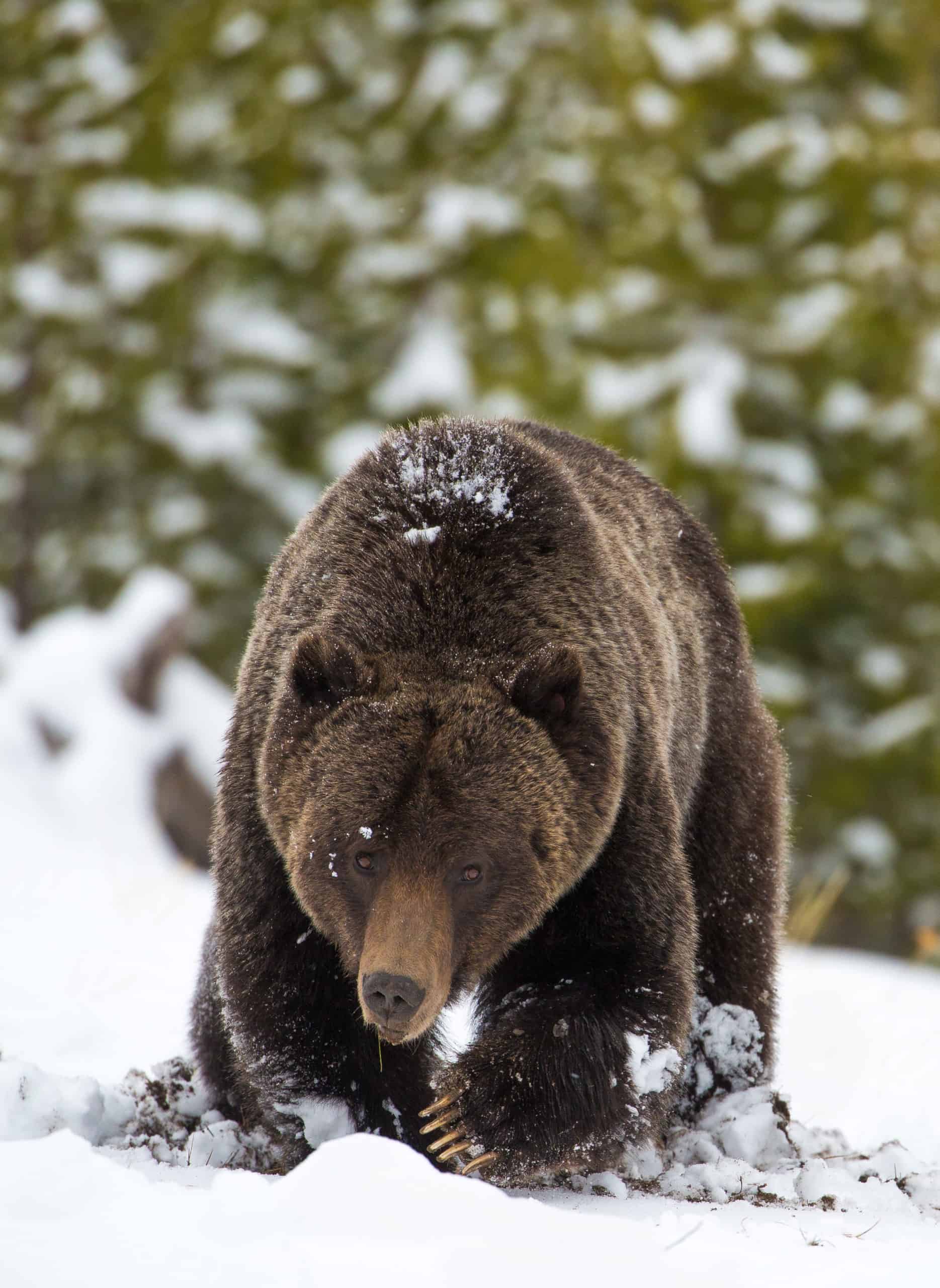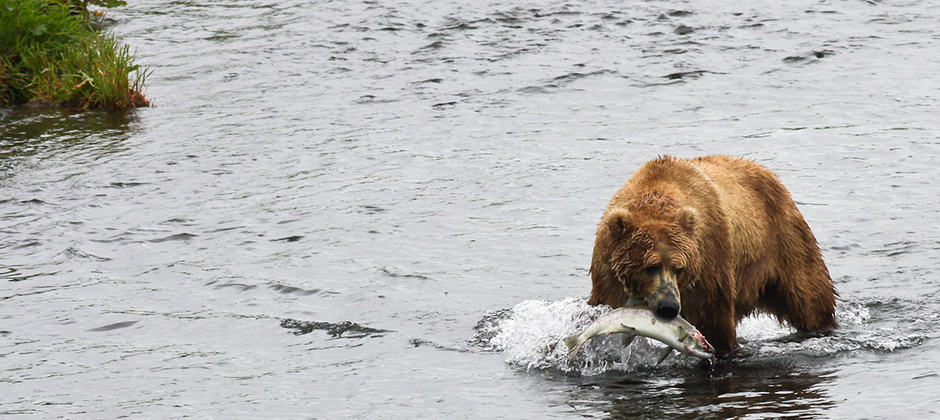Share this article
Q&A: Conserving bear culture
For decades, wildlife managers have worked widely with different bear species, from controlling problem bears in campsites, to conserving imperiled species like polar bears. This work has evolved greatly. For example, 60 years ago, managers fed grizzly bears garbage in Yellowstone and Glacier National Parks and black bears trash in Yosemite National Park. This is completely contrary to current bear management inside or outside national parks.

Chris Servheen was Grizzly Bear Recovery Coordinator for the U.S. Fish and Wildlife Service. Credit: J. Hadley/National Park Service
As managers have gathered more information, they also began treating subspecies like the Kodiak bears (Ursus arctos middendorffi) of Alaska or the Kermode bears (U. a. kermodei) of British Columbia as relatively unique ecological units. But in a review published in Ecology and Evolution, researchers suggest wildlife managers may also want to consider conserving the unique culture of certain sub-groups of bears.
“Culture in wildlife—that’s not something we normally talk about,” said TWS member Chris Servheen, an adjunct professor at the University of Montana, who was the Grizzly Bear Recovery coordinator for the U.S. Fish and Wildlife Service for 35 years. He recently co-authored the review on bear culture with Kerry Gunther from the Bear Management Office at Yellowstone National Park after being inspired by Andrew Whitten’s paper in 2021 in Science, “The burgeoning reach of animal culture,” and Hal Whitehead’s book on sperm whales, Sperm Whales: Social Evolution in the Ocean and his paper “Cultural hitchhiking in the matrilineal whales.”
These publications got him thinking about comparisons between matrilineal sperm whales (Physeter macrocephalus) and matrilineal bears. How might these familial relationships play a role in the animals’ cultures?
In this latest Q&A, we talked to Servheen, who is also the co-chair of the North American Bears Expert Team for the International Union for Conservation of Nature and board chair of the Montana Wildlife Federation, about bear culture and what it means for wildlife conservation and management.
How do bears have culture?
In matrilineal sperm whales, females stay together with their female offspring while males tend to disperse—and that’s exactly what bears do, too. With brown bears (Ursus arctos horribilis), female offspring tend to set up their home ranges within a portion of their mothers’ home range, resulting in overlapping home ranges among interrelated female bears. Because young brown bears stay with their mother for up to three years, they learn behaviors from their mothers and that is their culture. That results in generations of cultural transmission of information from mothers to offspring.
Bears have unique ways that they use resources in their home ranges. For example, some grizzly bears eat army cutworm moths (Euxoa auxiliaris) in the alpine. Only a small percentage of the population goes way up into the alpine and digs up talus slopes to eat these moths. It’s likely that many of the bears in these alpine areas eating moths are related groups of mothers, daughters, granddaughters and their male offspring. There will be other bears in that same general area with overlapping home ranges at lower elevations that never go to the alpine and use army cutworm moths because they never learned to use this resource from their mothers—it’s just not part of their culture.
Why is it important for wildlife managers to examine certain population’s cultures?
The unique cultures of bears, which have been around for thousands of years, allow them to use unique resources within their home ranges. In some cases, these resources may be really energetically important to them. If, through management actions, we eliminate those female animals that use these unique resources, then we eliminate that learned behavior that is their culture. A loss of a valuable cultural behavior likely reduces their long-term fitness.
When sport hunting was still going on in the Yellowstone ecosystem, grizzly hunters would often first go to alpine areas in late summer and fall to hunt bears because bears in the alpine were very vulnerable and visible while digging up moths. The potential was that the limited number of bears using the alpine could be eliminated by such hunts, and therefore that learned culture and the use of that unique resource would be lost over time. As managers, we need to make sure that animals can continue to maximize the use of resources in their home ranges by carefully managing to maintain these unique bear cultures.
All eight bear species worldwide likely use many unique resources some of which we know about but some we may not know of. Since most of the world is heavily impacted by human influence, it may be that we’ve already lost many unique bear cultures, likely resulting in detrimental effects to those populations, including reduced fitness, reproductive output and survival of the bears in those areas.
How do bear cultures differ? Could you give some examples?
The example of cutworm moths is one example. A subset of the population uses these cutworm moths—most bears in these ecosystems do not eat moths. Interestingly, I am not aware that grizzly bears have been documented using cutworm moths in Canada. It’s mysterious because there are moths up there, but no grizzly bears are known to eat them. It appears that there is a culture of moth use in some areas but that culture either never existed, or it’s gone from other areas.
Another example is the grizzly bears that use spawning cutthroat trout in streams around Yellowstone Lake in Yellowstone Park. Only a small percentage of the Yellowstone Ecosystem grizzly bears ever feed on trout. Another example is on some islands off the coast of Alaska where most brown bears eat spawning salmon, but some bears on the same islands never feed on salmon because they’ve never learned to go do that.

Grizzly bears may have unique cultures similar to other matrilineal mammals like sperm whales. Credit: J. Hadley/National Park Service
Are there ways in which management may fall short when conservationists don’t consider the culture of bear populations?
For animals living in places with relatively low human influence, culture is a positive attribute. We think of culture as a positive attribute because it allows these bears to effectively use all the resources available in “wild habitats” where the number of human influences is pretty low. We need to carefully manage to allow unique and valuable animal cultures to continue to exist like alpine cutworm moth use. Anything that reduces the security in the alpine areas like high number of hikers or bear hunting can deter or eliminate bear use of the moth sites.
Habituation to humans is another behavior transmitted to offspring. Females willing to be around people, whether it’s on a roadside or in a residential area, in many cases are the offspring of animals that have done that in the past. The survival of these animals is low because they get into trouble with people, as they get into garbage, gardens, bird feeders and pet food. As managers, if we allow this maladaptive culture to go on, we’ll have more and more bears living among people in residential areas. The mortality of bears in these areas due to learned cultural behavior to be around humans can turn such areas into ecological traps that continually draw bears.
Do you have anything else to add on the topic?
It’s a subject that really made me think outside the box. Are all these groups of related female bears that use unique resources like moths in the alpine low in mitochondrial diversity because all the females in these areas are related? That is the case in matrilineal groups of sperm whales. It would be really interesting to learn about the mitochondrial diversity of the female bears using unique resources that they have learned to use due to the culture of their mothers.
Andrew Whitten’s paper in Science really opened my eyes to the fact that there’s so much culture in animals that we’ve ignored. It was kind of a head-slapping moment for me. In a way, these sperm whales are just like bears. All females live together, they stay together, and they transmit information on resource use to each other from generation to generation. The groups of female sperm whales even have unique vocalizations called codas that they use to communicate among their clan members. It’s really fascinating not just to look at the food habits of animals or their movement patterns—we do that all the time as wildlife managers—but to look at their unique cultures and how they’ve adapted over generations to use the resources in their habitat. We, as humans, are dramatically changing wildlife habitat worldwide, and by so doing we are altering wildlife culture thereby reducing their ability to get along with humans and to survive. It’s important to think about what we can do to identify and carefully maintain important wildlife cultures and to reduce maladaptive cultures such as seeking human foods, particularly with bears.
Header Image: Some bears in Kodiak Island specialize on feeding on salmon while others don’t. Credit: Lisa Hupp/U.S. Fish and Wildlife Service








